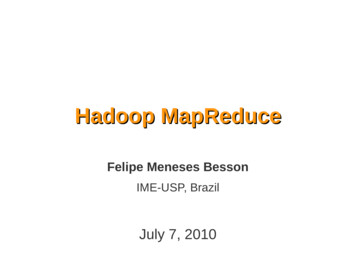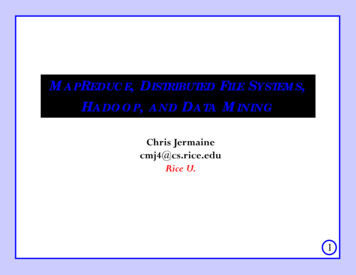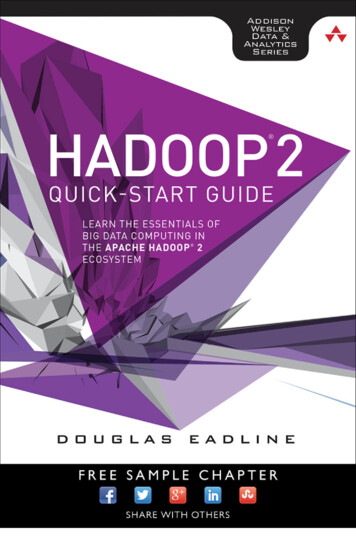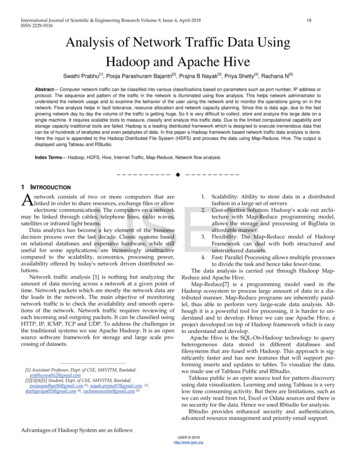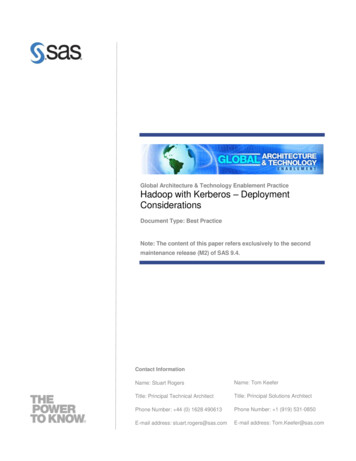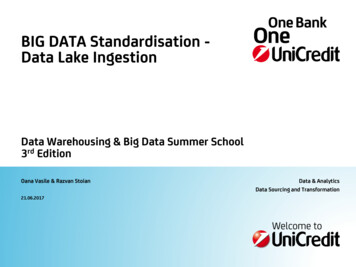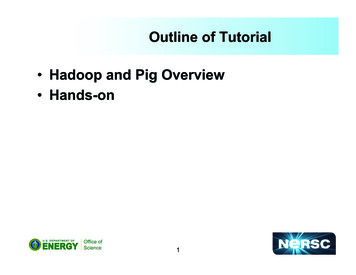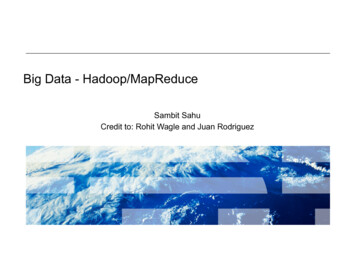
Transcription
Big Data - Hadoop/MapReduceSambit SahuCredit to: Rohit Wagle and Juan Rodriguez
Agenda!Why Big Data?!Apache 2
Hypothetical Job! You just got an awesome job at data-mining start-up .Congratulations !!– Free Snacks, Soda and Coffee --- Yayy!!! Your first day of work you are given a task– The company has a new algorithm they want you to test.– Your boss gives you The algorithm library A test machine and 1GB input data file3
Java Document Scorer ProgramRead InputProcess DataThroughput 1GB per hour.4What if we wanted to process 10GB data set? 10hours!!How can we improve the performance?
Some Options1. Faster CPU2. More Memory3. Increase the number of cores4. Increase the number of threads5. Increase the number of threads and cores5
Java Document Scorer Program – Multi ThreadedThroughput 4GB per hour.How long for 100GB?What else can we do?6
Get An Even Faster Machine with more Cores?Source: MIT Open Courseware
Current ToolsProgramming models##"Shared memory (pthreads)Message passing (MPI)P1 P2 P3 P4 P5Design Patterns###Message PassingMemory"Shared MemoryP1 P2 P3 P4 P5Master-slavesProducer-consumer flowsShared work queuesmasterproducer consumerwork queueslavesproducer consumer
Where the rubber meets the road"Concurrency is difficult to reason about"Concurrency is even more difficult to reason about###At the scale of datacenters (even across datacenters)In the presence of failuresIn terms of multiple interacting services"Not to mention debugging "The reality:###Lots of one-off solutions, custom codeWrite you own dedicated library, then program with itBurden on the programmer to explicitly manage everything
What’s the common theme?"To improve performance, you have to re-write the code"The code has to adapt to the expected performance.#"This doesn’t work since you may not know the amount of databeforehand.The actual Intellectual Property (IP) of the company is theanalytic algorithm#However a lot of effort is spent on scaling the analytic
Big Data - Motivation! Google processes 20 PB a day (2008)! Wayback Machine has 3 PB 100 TB/month (3/2009)! Facebook has 2.5 PB of user data 15 TB/day (4/2009)! eBay has 6.5 PB of user data 50 TB/day (5/2009)! CERN’s LHC will generate 15 PB a year640K oughtto be enoughfor anybody.11
Enter . Apache Hadoop! Hadoop is a high-level Open Source project– Under Apache Software Foundation– Inspired by Google’s MapReduce and GFS papers! It contains several individual projects– HDFS– MapReduce– Yarn! It also has a slew of related projects– PIG– HIVE– Hbase! Has been implemented for the most part in Java.12
A closer lookPartition WorkCombine Results
Divide and ker”“worker”r1r2r3“Result”Combine
Parallelization Challenges"How do we assign work units to workers?"What if we have more work units than workers?"What if workers need to share partial results?"How do we aggregate partial results?"How do we know all the workers have finished?"What if workers die?What is the common theme of all of these problems?
What’s the point?"It’s all about the right level of abstraction#"Hide system-level details from the developers#"The von Neumann architecture has served us well, but is no longerappropriate for the multi-core/cluster environmentNo more race conditions, lock contention, etc.Separating the what from how##Developer specifies the computation that needs to be performedExecution framework (“runtime”) handles actual executionThe datacenter is the computer!
“Big Ideas”"Scale “out”, not “up”#"Move processing to the data#"Cluster have limited bandwidthProcess data sequentially, avoid random access#"Limits of SMP and large shared-memory machinesSeeks are expensive, disk throughput is reasonableSeamless scalability#From the mythical man-month to the tradable machine-hour
Hadoop! Platform for distributed storage and computation– HDFS– MapReduce– EcosystemSource: Hadoop in Practice, Alex Holmes, Manning Publications Co., 201218
What are we missing here?Sequential File ReadPartition WorkCombine Results19
Hadoop! Platform for distributed storage and computation– HDFS– MapReduce– EcosystemSource: Hadoop in Practice, Alex Holmes, Manning Publications Co., 201220
How do we get data to the workers?NASSANCompute NodesWhat’s the problem here?
HDFS: Assumptions! Commodity hardware over “exotic” hardware– Scale “out”, not “up”! High component failure rates– Inexpensive commodity components fail all the time! “Modest” number of huge files– Multi-gigabyte files are common, if not encouraged! Files are write-once, read many– Perhaps concurrently! Large streaming reads over random access– High sustained throughput over low latency22GFS slides adapted from material by (Ghemawat et al., SOSP 2003)
HDFS ArchitectureHDFS namenodeApplication(file name, block id)HDFS Client/foo/barFile namespaceblock 3df2(block id, block location)instructions to datanode(block id, byte range)block datadatanode stateHDFS datanodeHDFS datanodeLinux file systemLinux file system Adapted from (Ghemawat et al., SOSP 2003)
How HDFS works"When an input file is added to HDFS###File is split into smaller blocks of fixed sizeEach block is replicatedEach replicated block is stored on a different host"Block size is configurable. Default is 128/256MB."Replication level is configurable. Default is 3#Replication is necessary for Scaling High Availability"In case a host crashes or is removed#"All blocks on that host are automatically replicated to other hostsIn case a host is added#Blocks will be rebalanced so that some blocks from other hosts will beplaced on the new host
HDFS Component Responsibilities! Name Node– Managing the file system namespace: Holds file/directory structure, metadata, file-to-block mapping, access permissions, etc.– Coordinating file operations: Directs clients to datanodes for reads and writes No data is moved through the namenode– Maintaining overall health: Periodic communication with the datanodes Block re-replication and rebalancing Garbage collection! Data Node– Actual storage and management of data block on a single host– Provides clients with access to data25
HDFS26
HDFS Components in Clustermaster nodenamenodenamenode daemondatanode daemondatanode daemondatanode daemonLinux file systemLinux file systemLinux file system slave node27 slave node slave node
Hadoop! Platform for distributed storage and computation– HDFS– MapReduce– EcosystemSource: Hadoop in Practice, Alex Holmes, Manning Publications Co., 201228
MapReduce (MR) can refer to "The execution framework (aka “runtime”)"The programming model"The specific implementationUsage is usually clear from context!
MR Framework Components! Job Tracker– Central component responsible for managing job lifecycles– One Job Tracker per MR framework instance– Accepts job submissions, queries etc. from clients– Enqueues jobs and schedules individual tasks.– Communicates with Task Trackers to deploy and run tasks– Attempts to assign tasks to support Data Locality.! Task Tracker– One Task Tracker per host– Runs and manages individual tasks– Communicates progress of tasks back to Job Tracker.30
MR Programming Model"Programmers specify two functions:map (k, v) k’, v’ *reduce (k’, v’) k’, v’ *# All values with the same key are sent to the same reducer"The MR Execution framework handles everything else What’s “everything else”?
MapReduce! Everything Else! Handles scheduling– Assigns workers to mapand reduce tasks! Handles “data distribution”– Moves processes to data! Handles synchronization– Gathers, sorts, and shufflesintermediate data! Handles errors and faults– Detects worker failuresand restarts! Everything happens on topof a distributed FS (HDFS)32
Our Scoring Algorithm as a Map Reduce ProgramOur Analytic33
Basic Hadoop API*"Mapper###"Reducer/Combiner###"void map(K1 key, V1 value, OutputCollector K2, V2 output,Reporter reporter)void configure(JobConf job)void close() throws IOExceptionvoid reduce(K2 key, Iterator V2 values,OutputCollector K3,V3 output, Reporter reporter)void configure(JobConf job)void close() throws IOExceptionPartitioner#void getPartition(K2 key, V2 value, int numPartitions)*Note: forthcoming API changes
k1 v1k2 v2mapa 1k3 v3k4 v4mapb 2c3k5 v5k6 v6mapc 6a 5cmap2b 7cShuffle and Sort: aggregate values by keysa1 5b2 7c2 3 6 8reducereducereducer1 s1r2 s2r3 s38
Lets Talk Numbers"How many mappers?###"Depends on the size of input dataTypically 1 mapper per data blockSo 1 GB input data will have around 8 Mappers Assuming 128MB block sizeHow many reducers?###Depends on cluster reducer capacityCan be set depending on the expected number of keysFor large data sets, set it to cluster reducer capacity
MapReduce"Programmers specify two functions:map (k, v) k’, v’ *reduce (k’, v’) k’, v’ *# All values with the same key are reduced together"The execution framework handles everything else "Not quite usually, programmers also specify:combine (k’, v’) k’, v’ *# Mini-reducers that run in memory after the map phase# Used as an optimization to reduce network trafficpartition (k’, number of partitions) partition for k’# Often a simple hash of the key, e.g., hash(k’) mod n# Divides up key space for parallel reduce operations
Two more details "Barrier between map and reduce phases#"But we can begin copying intermediate data earlierKeys arrive at each reducer in sorted order#No enforced ordering across reducers
k1 v1k2 v2mapa 1k4 v4mapb 2ccombinea 1k3 v33cpartitionk6 v6mapc 6a 5combineb 2k5 v5cmap2b 7combine9a 5partitionc1 52b 7partitionb2 78combinecpartitionShuffle and Sort: aggregate values by keysacc2 9 8reducereducereducer1 s1r2 s2r3 s38
Input To MappersInputFormatInput FileInput rmediatesSource: redrawn from a slide by Cloduera, cc-licensed
Shuffle and Sortintermediate files(on disk)Mappermerged spills(on disk)Reducercircular buffer(in memory)spills (on disk)other mappersother reducers
Shuffle and Sort in Hadoop"Probably the most complex aspect of MapReduce!"Map side###"Map outputs are buffered in memory in a circular bufferWhen buffer reaches threshold, contents are “spilled” to diskSpills merged in a single, partitioned file (sorted within eachpartition): combiner runs hereReduce side###First, map outputs are copied over to reducer machine“Sort” is a multi-pass merge of map outputs (happens in memoryand on disk): combiner runs hereFinal merge pass goes directly into reducer
(combiners omitted rReducerReduceSource: redrawn from a slide by Cloduera, cc-licensed
OutputFormatReducer to RecordWriterOutput FileOutput FileOutput FileSource: redrawn from a slide by Cloduera, cc-licensed
Input and tInputFormatSequenceFileInputFormat Format
Putting everything together namenodejob submission nodenamenode atanode daemondatanode daemondatanode daemonLinux file systemLinux file systemLinux file system slave node46 slave node slave node
HADOOP Architecture! Master– NameNode– JobTracker! Slaves– Data Node– Compute Node– Why together? Data Locality47
One More Thing! Distributed Cache–Usually used for files of small size– Provides a convenient way to propagate applications and configurationfiles– HDFS is not used handle such files due to their small size– Shared across all nodes in the MapReduce cluster48
Dizzy Yet?! OK, we went through a lot of details! Whatever happened to the simplicity of programming?! Do I really have to write a MapReduce program every time I want to run a newanalytic?49
We went from.Multi-Threaded50Map-Reduce
Enter PIG Oink!! High Level Languages for Map-Reduce– PIG Developed by Yahoo– HIVE Developed by Facebook– JAQL Developed by IBM! All of these languages provide similar functionality! All of them allow users to plug in their own user defined functions (UDFs)51
Lets get Practical – From Setup to ResultsSetting up a Hadoop Cluster! Minimum recommended configuration (4 Hosts)– 1 Host Dedicated for Management Services (Job Tracker, Name Node etc)– 3 Hosts as Slave nodes (Data Node , Task Trackers)! Data nodes should have high capacity local disks attached.– This is where all your data is going to be! How much total disk space?– Depends on input data to be processed– Effective Storage Space Recommended: Typically 3 times your input data size– Actual Storage Space: Effective Storage Space * 3 (replication level)! Single node installation is fine for development/testing on very small data– Perhaps not the best for testing performance! Installation instructions vary from provider to provider52
Some cluster configuration parameters! HDFS configuration parameters– Stored in hdfs-site.xml– Block size– Default replication count! MapReduce configuration parameters– Stored In “mapred-site.xml”– Java heap size for mappers/reducers– Number of mappers/reducers per host See s! IMPORTANT– Job Tracker URL: http:// masterhost :50030– Name Node URL: http:// masterhost :5007053
Job Tracker Web Page (port 50030)54
Working with data! Lets say you have 1 GB of data in your local filesystem (mydata.txt)! Load into HDFS– hadoop fs –mkdir /path/mydirectory– hadoop fs –put mydata.txt /path/mydirectory– where /path/mydirectory is in HDFS! List the file you just uploaded– hadoop fs –ls /path/mydirectory! “hadoop fs” works similar to linux filesystem commands– However HDFS is not POSIX compliant.– It cannot be mounted as a regular filesystem55
Writing your program . see the simplicity!!! JAQL program for running our scorer! PIG program for running our scorer56
All languages provide similar functionality! LOAD (various data formats)! JOIN! FOR-EACH! GROUP! SORT! FILTER! Pluggable UDFs57
Hadoop Programming Tips! Thinking at scale– Filter unwanted data earlier in the flow– Store intermediate data– Use “sequence” format for storing data.! These are not iterative languages– i.e. No for or while loops! Watch out for obvious bottlenecks– Single key for all mapper output will send data to one reducer– Too much data sent to a UDF will result in OOM errors58
Submitting a Job! Create and save your PIG script (myscript.pig)! To deploy (pig command will be in your installation)– pig –f myscipt.pig– Command will complete once your job completes! To check the status of your job– Use the Job Tracker URL (easiest) OR– hadoop job –list (will print all job ids)– hadoop job –status jobid (will print the job status)! To get the results– hadoop fs –get /path/results.txt .59
Anatomy of a Job"MapReduce program in Hadoop Hadoop job###"Jobs are divided into map and reduce tasksAn instance of running a task is called a task attemptMultiple jobs can be composed into a workflowJob submission process######Client (i.e., driver program) creates a job, configures it, andsubmits it to job trackerJobClient computes input splits (on client end)Job data (jar, configuration XML) are sent to JobTrackerJobTracker puts job data in shared location, enqueues tasksTaskTrackers poll for tasksOff to the races
Hadoop Workflow1. Load data into HDFS2. Develop code locally3. Submit MapReduce job3a. Go back to Step 2YouHadoop Cluster4. Retrieve data from HDFS
Uh Oh. My Job Failed Now what?"First, take a deep breath"Start small, start locally"Strategies####"Learn to use the webappWhere does println go?Don’t use println, use loggingThrow RuntimeExceptionsLogs are most easily accessible via the Job Tracker URL
How about a Demo
Time for a Raise"Finally you have mastered Hadoop Big Data"Your applications are scaling.#"Boss##"Can we query the data for specific entities?How long will that take?Problem##"You deserve a raise!!Remember this is still sequential accessTo find a specific entity, you still need to read the entire data set.What now?#How is this solved in traditional systems?Databases
Enter - HBASE"NOSQL Data Stores"But that’s another discussion
Questions?
Resources"Papers###"URLS#"Google File System, 2003Google MapReduce, 2004Google Bigtable, 2006Apache Hadoop: http://hadoop.apache.orgAvailable Hadoop Distributions#Apache, IBM, Cloudera, Hortonworks
Other projects based on Hadoop"HBase"Hive"PIG"Spark"Mahout
Hive – a SQL-like data warehouse y/Hive/Tutorial"Supports a SQL-like data warehouseon top of Hadoop – began at Facebook"Provides SQL users the capability ofbig data without requiring lower levelprogramming for a wide range of tasks"Fewer lines of code!"/bin/hive –help
Hive Architecture"Main components####SQL interfaceParser/PlannerMetastoreDriver
Wordcount Example
Hive Data Model – partition and cluster"Tables stored under user/hive/warehouse in HDFS"Partition columns"Buckets – allows to create smaller range partitions
A simple illustration of MR process
YARN
Hadoop Eco-system (prior to Hadoop 2)
Larger View
MR Patterns Examples"Jimmy Lin’s book"Jeffrey Ulman’s book"An excellent blog: preducepatterns/
Big Data - Motivation ! Google processes 20 PB a day (2008) ! Wayback Machine has 3 PB 100 TB/month (3/2009) ! Facebook has 2.5 PB of user data 15 TB/day (4/2009) ! eBay has 6.5 PB of user data 50 TB/day (5/2009) ! CERN’s LHC will g

